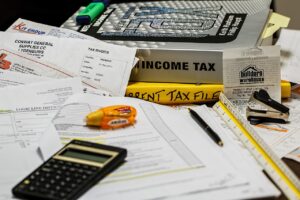How to Look Up Federal Tax ID Numbers
Navigating the world of taxes can feel like a labyrinth, especially when it comes to identifying key numbers. Among these, the Federal Tax ID Number—officially known as an Employer Identification Number (EIN)—is essential for businesses and organizations. Whether you’re starting a new venture or handling tax filings for an established company, knowing how to look up your Federal Tax ID number is crucial. This little sequence of digits holds significant power in managing your finances and complying with federal regulations. Let’s dive into what this number is all about and how you can easily find it when you need it most.
What is a Federal Tax ID Number?
A Federal Tax ID Number, commonly called an Employer Identification Number (EIN), is a unique identifier issued by the Internal Revenue Service (IRS). It serves as a Social Security number for businesses, allowing them to conduct various financial activities.
Organizations use this number for tax reporting purposes. Whether you’re filing taxes or opening a business bank account, your EIN is essential.
It consists of nine digits and follows the format XX-XXXXXXX. This simple yet powerful series of numbers plays a crucial role in identifying your business entity within the IRS system.
From corporations to partnerships and non-profits, obtaining an EIN is often necessary when engaging with federal tax obligations. Essentially, it helps streamline processes while ensuring compliance with the law.
Why You Might Need a Federal Tax ID Number
A Federal Tax ID Number, also known as an Employer Identification Number (EIN), plays a vital role for businesses. If you plan to hire employees, you’ll need one. This number helps the IRS track your payroll taxes and employee records.
Starting a business often requires opening a bank account in the company’s name. A Federal Tax ID is typically necessary for this process. Banks want assurance that they’re dealing with a legitimate entity.
For tax purposes, having an EIN can simplify your filing process. It allows you to separate personal finances from business income and expenses, which provides clarity during tax season.
Additionally, certain licenses and permits demand an EIN before approval. This requirement ensures compliance with federal regulations and local laws when starting or expanding your operations.
How to Obtain a Federal Tax ID Number
To obtain a Federal Tax ID Number, also known as an Employer Identification Number (EIN), start by determining your eligibility. Typically, businesses and certain organizations need an EIN for tax purposes.
The easiest way to apply is through the IRS website. You can complete the online application in just a few minutes. Make sure you have all necessary information ready, such as your business structure and ownership details.
If you prefer offline methods, you can fill out Form SS-4 and mail it to the IRS or fax it if you’re in a hurry.
Be aware that international applicants may have different procedures. They might need to call the IRS directly for assistance with acquiring their EIN.
Keep in mind that obtaining this number is free of charge, so beware of any service offering to do it for a fee.
Where to Look for Your Company’s EIN
Finding your company’s Employer Identification Number (EIN) can be straightforward if you know where to search.
Start by checking the original documents from when you applied for the EIN. This could include your IRS confirmation letter or any tax returns you’ve filed. Keep these documents in a safe place for future reference.
If those aren’t available, look at bank statements and other financial records. Many banks require an EIN to open a business account, so it may be noted there.
Another option is accessing your online tax account with the IRS. If you’ve registered, you can log in and find relevant data about your business, including the EIN.
Don’t hesitate to reach out directly to the IRS if you’re still stuck. They are equipped to assist with inquiries regarding lost or misplaced numbers.
What to Do if You Can’t Find Your EIN
Misplacing your Employer Identification Number (EIN) can be frustrating. If you can’t find it, don’t panic; there are steps you can take.
Start by checking your IRS documents. Look through past tax returns or any correspondence from the IRS. Often, this information is included on these forms.
If that doesn’t yield results, try contacting the IRS directly. Their Business & Specialty Tax Line is available for inquiries related to EINs. Be prepared to provide identifying details about your business to verify ownership.
Another option is to check with your bank or financial institution. They may have records of your EIN if you’ve opened a business account using it.
Consider accessing online services that offer assistance in retrieving lost EINs for a fee. These professionals can simplify the process and help you recover necessary documentation efficiently.
Alternatives to Using a Federal Tax ID Number
If you’re unable to use a Federal Tax ID Number, several alternatives can serve your needs. One option is the Social Security Number (SSN). This is especially useful for sole proprietors or individuals managing small businesses.
Another alternative is the Individual Taxpayer Identification Number (ITIN). This number caters specifically to those who are not eligible for an SSN yet need to fulfill tax obligations.
For certain transactions, some organizations may accept a business license number instead. It’s wise to check with your bank or financial institution whether they’ll recognize this in place of an EIN.
In addition, if you’re involved in government contracts or grants, sometimes using a DUNS Number can suffice. Each situation varies; always confirm which identification will suit your specific requirements best.
Conclusion
Navigating the world of federal tax ID numbers can feel overwhelming, especially if you’re unfamiliar with the terminology. Understanding your Federal Tax ID Number (also known as an Employer Identification Number or EIN) is crucial for various business activities, including tax filings and opening bank accounts. 
If you find yourself in need of this number, remember that obtaining it through the IRS is a straightforward process. You can apply online or via mail depending on your preference. Once you have it, keep it secure and accessible.
If you’ve misplaced your EIN or haven’t received one yet, there are several ways to locate it. Checking previous tax documents or reaching out directly to the IRS can help solve your problem quickly.
For those who encounter difficulties finding their EIN despite these methods, alternative resources like state records may offer additional insights into business identification numbers relevant in specific contexts.
Having access to accurate information about federal tax IDs is essential for managing business affairs effectively. Whether you’re starting a new venture or maintaining an existing one, knowing how to look up federal tax ID numbers ensures you’re always prepared for compliance and growth opportunities that lie ahead.



